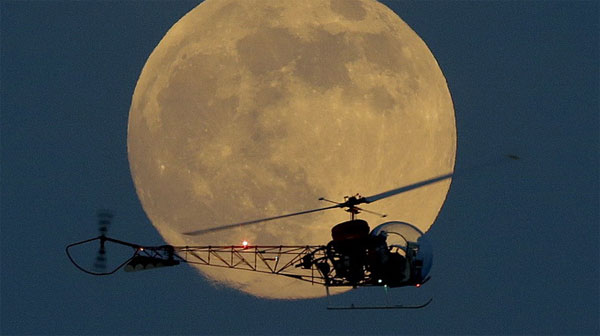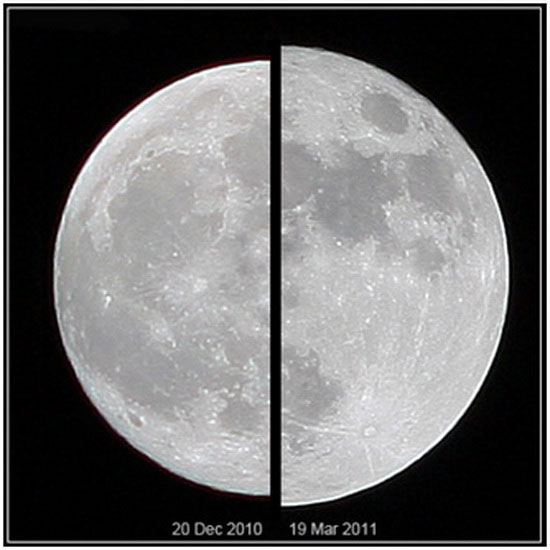11/8 watch the latest
Night 10 am 11/8 (Vietnam time), the time of the latest and brightest full moon in 2014 or the latest 'super moon' .

"Super moon"is seen behind a helicopter in New Jersey, USA in June 2013 - (Photo: AP)
According to Mr. Dang Tuan Duy - chairman of HCMC Amateur Astronomical Club (HAAC), it is worth noting that the event on August 10 and 11 is the full moon (full moon) and the time when the Moon reaches. the perigee position , almost at the same time (only 20 minutes apart). This extreme approach is also when the Moon reaches its closest position to Earth in 2014 , at a distance of 356,896km (according to fourmilab). Scientists say the Moon will not approach the Earth at the same distance until September 28, 2015.
This is an interesting astronomical phenomenon because according to some scientists, when the 'super moon' takes place, the moon may be 12-14% bigger and 30% brighter than usual. However, it is difficult for the naked eye to recognize this difference if there is no measuring tool (the best way to distinguish it is to capture the normal Moon and Moon at "super moon" with the same camera focus and compare it). ).
In 2014, the Moon also had several full moons (June 13 and September 9) and was also called "super moon" , but the distance between the Moon - the larger Earth and the time between access points and full moon are also quite far apart, not at the same time compared to August 10 and 11.

The picture compares the usual full moon on December 20, 2010 (left) and "super moon" on March 19, 2011 - (Photo: Wikimedia Commons)
Things you may not know about "super moon"
1. The term 'super moon' does not originate from astronomy but from astrology. According to astrologer Nolle at astropro.com website (the website originated this name), in 1979 he defined: 'The new moon or full moon occurs when the Moon is in the right position or near the position ( 90%) it reaches the extreme (closest) to Earth in its orbit (perigee position) ' . According to Nolle, one year may have 4-6 super moons.
2. Three years ago, on March 19, the full moon at the same time with the extreme position was called the 'super moon' that astronomers had never used. In the next few years, the term 'super moon' is more commonly used for several times the full moon at the point of close proximity.
3. It is estimated that once every 413.4 days (1 year 1 month and 18 days), a "super moon" will take place, ie the full moon will take place at the same time as its peak position.
4. The 'super moon' time that the Moon has a distance of <356,500km is very rare, the first time in the 21st century is November 25, 2034 (356,456km) and the smallest distance in the 21st century is on December 6, 2052 (356,425km). And to reach the distance
5. Many people believe that the full moon event coincides with the near-point position that will affect the climate types on Earth. However many scientists deny this. They claim that the "super moon" will not cause any geological events, creating only some differences with the rise and fall of the tide. If it resonates with certain weather conditions, it may cause some problems in coastal areas.
Dang Tuan Duy - Chairman of HCMC Amateur Astronomy Club (HAAC)
- Why when watching live football, have a fast TV, have a slow TV?
- Alcohol meter
- Video: The process of making the most expensive watch in the world
- The watch was so accurate that it did not deviate from time for 40 million years
- Frogs watch videos on phones
- What is the accuracy of the clock, and is anyone really interested in it?
- Seiko launches a watch capable of charging the phone
- Synthesis of free TV viewing apps on Android
- Wrist watch countdown death
- LG joins the smart watch market
- Releasing watches can save users' lives
- Watch comedy every day
 Van Allen's belt and evidence that the Apollo 11 mission to the Moon was myth
Van Allen's belt and evidence that the Apollo 11 mission to the Moon was myth The levels of civilization in the universe (Kardashev scale)
The levels of civilization in the universe (Kardashev scale) Today Mars, the sun and the Earth are aligned
Today Mars, the sun and the Earth are aligned The Amazon owner announced a secret plan to build a space base for thousands of people
The Amazon owner announced a secret plan to build a space base for thousands of people